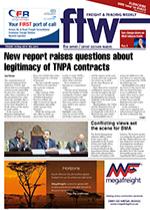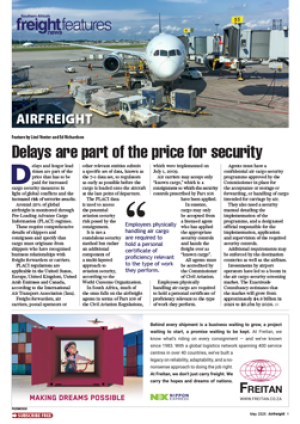The Border Management Authority (BMA), which in due course will be responsible for all 72 ports of entry into South Africa, was in the spotlight at a recent presentation by the Department of Home Affairs (dha) at the Johannesburg Chamber of Commerce and
Industry. The keynote speaker was acting director general of the dha, Thulani Mavuso, seen here flanked by Gavin Colazo of immigration consultancy firm, Fragomen, and Elroy Africa, project manager of the BMA. See FTW’s reports about public-private issues regarding the BMA on page 8.
The South African Association of Freight Forwarders (Saaff) has made its strongest expression yet regarding the muchdelayed and long-awaited consolidation of all border control entities into one unified behemoth – the Border Management Authority (BMA). Last week, during a question and answer session at the Johannesburg Chamber of Commerce and Industry where the Department of Home Affairs (dha) gave a BMA presentation, Saaff representative Johan Marais didn’t mince his words. For starters, he questioned BMA project manager Elroy Africa’s contention that the authority had been conceived and crafted in consultation with the private sector. “In my experience this is the first time since 2013 (when
the BMA was decided on) that we have been given an overall presentation.” More alarmingly, Marais added that “BMA discussion with the private sector is chronically lacking”. In fairness, he complimented the dha for an “enlightening and comprehensive presentation” but, cutting to the quick, stressed that Saaff and its members had serious reservations about the implementation of the BMA. This is despite Africa’s explanation that the BMA will be instituted over several phases, culminating in a final implementation date of sometime in 2032. Mostly it was the complexity of the task at hand that worried freight forwarders, Marais said. “The concept of a coordinated border management authority is supported by us 100% but it’s a mammoth task.”
Saaff, he said, was particularly concerned about the disruptive effect that a change-over in personnel and skills could have on freight and trade. “Taking all the relevant acts into consideration, for these to now be selectively enforced by the BMA you are obviously going to look at staffing. “It means you will have to negotiate with public servants about transferring people out of their principal departments into the BMA.” Considering South Africa’s persistent issues with labour disputes and resulting strikes, it was important that this changeover happened with little if any effect – hopefully – on customs, import and export control, immigration, policing and the various services required by border managements, he said, adding that it was important for the dha to grasp how crucial the movement of freight was for international trade. “We simply cannot afford to have goods coming into South Africa delayed because of a lack of integrated systems.
The concept of a coordinated border management authority is supported by us 100% but it’s a mammoth task – Johan Marais
VS
The roll-out of South Africa’s Border Management Authority (BMA) – which will oversee the country’s borders and ports of entry, including customs and policing – appears to be making a slow start. A pilot phase for the launch of what will be a “centralised command and
control” centre is yet to be announced, but acting director general for the Department of Home Affairs, Thulani Mavuso, told delegates at a Johannesburg Chamber of Commerce and Industry (JCCI) business breakfast last week that “safeguarding the territory of our country” was a critical priority. Demonstrating the enormity of the challenge, Mavuso said that 40 million travellers
passed through SA’s borders annually – and the 369 726 illegal tourists deported between 2011 and 2016 were most likely a drop in the ocean considering the World Bank’s estimation that the country had become a home to some 10 million refugee claimers. Mavuso said that for the most part, 90% of these so-called refugees were just opportunity seekers – “economic migrants whose claim of refugee status is rejected”. As for unauthorised items imported into the country, the National Regulator of Compulsory Specifications has recorded R1 billion in illicit goods coming into SA over the last five years. Contraband clothing on its own has reached staggering proportions, with the SA Revenue Service (Sars) and the SA Police Service (Saps) seizing seven million items of clothing between 2011/12.
A pilot phase for the launch of what will be a “centralised command and control” centre is yet to be announced. “ – Thulani Mavuso

